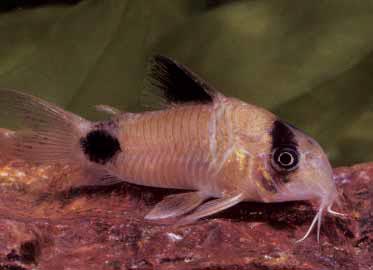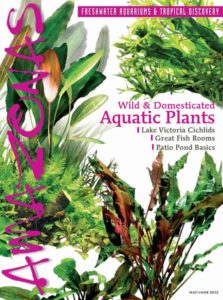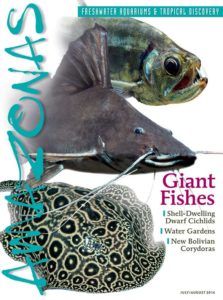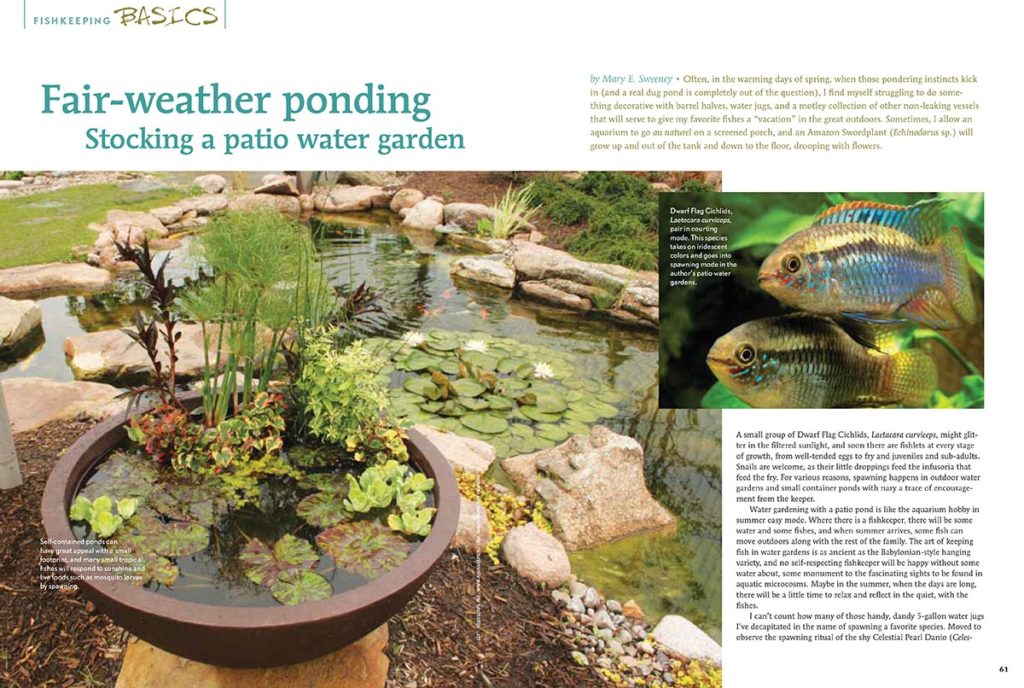
Fair Weather Ponding by Mary Sweeney, as originally published in the May/June 2012 issue of AMAZONAS magazine.
by Mary E. Sweeny
This article first appeared in the May/June 2012 issue of AMAZONAS Magazine; get the back issue now!
Often, in the warming days of spring, when those pondering instincts kick in (and a real dug pond is completely out of the question), I find myself struggling to do something decorative with barrel halves, water jugs, and a motley collection of other non-leaking vessels that will serve to give my favorite fishes a “vacation” in the great outdoors. Sometimes, I allow an aquarium to go au naturel on a screened porch, and an Amazon Swordplant (Echinodorus sp.) will grow up and out of the tank and down to the floor, drooping with flowers.
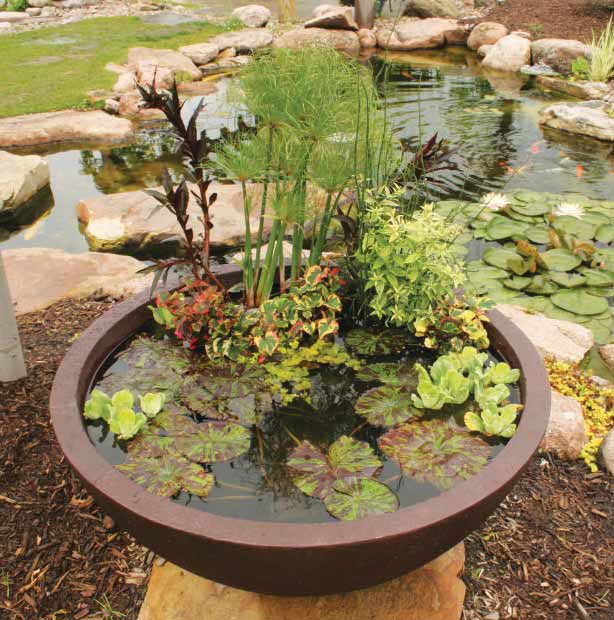
Self-contained ponds can have great appeal with a small footprint, and many small tropical fishes will respond to sunshine and live foods such as mosquito larvae by spawning. Image by Aquascape Inc., www.aquascapeinc.com
A small group of Dwarf Flag Cichlids, Laetacara curviceps, might glitter in the filtered sunlight, and soon there are fishlets at every stage of growth, from well-tended eggs to fry and juveniles and sub-adults. Snails are welcome, as their little droppings feed the infusoria that feed the fry. For various reasons, spawning happens in outdoor water gardens and small container ponds with nary a trace of encouragement from the keeper.
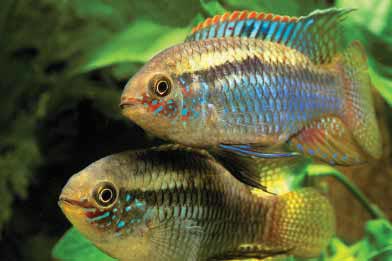
Dwarf Flag Cichlids, Laetecara curviceps, pair in courting mode. This species takes on iridescent colors and goes into spawning mode in the author’s patio water gardens. Image by Christian Piednoir.
Water gardening with a patio pond is like the aquarium hobby in summer easy mode. Where there is a fishkeeper, there will be some water and some fishes, and when summer arrives, some fish can move outdoors along with the rest of the family. The art of keeping fish in water gardens is as ancient as the Babylonian-style hanging variety, and no self-respecting fishkeeper will be happy without some water about, some monument to the fascinating sights to be found in aquatic microcosms. Maybe in the summer, when the days are long, there will be a little time to relax and reflect in the quiet, with the fishes. I can’t count how many of those handy, dandy 5-gallon water jugs I’ve decapitated in the name of spawning a favorite species. Moved to observe the spawning ritual of the shy Celestial Pearl Danio (Celestichthys margaritatus), I decided to set a jug on a bench among the conventional flowerpots that adorn our entryway. Filling a clean 4-inch clay flowerpot with aquarium gravel, I planted a single Madagascar Lace Plant (Aponogeton madagascariensis) bulb, tip showing, in the clay pot and placed the pot in the center of the clear jug. A shallow layer of aquarium gravel covered the bottom of the jug and helped to anchor the pot. I slowly filled the jug halfway with a combination of aquarium water and aged tap water.
Within days, the green tips of the Lace Plant could be seen emerging from the substrate. Several days later, I introduced a trio of two females and one male of the tiny danionins to the container. A little fresh water was added to the container every day or so, and I would remove some of the water to use in the flowerpots nearby. Over the course of the summer, the male could often be seen displaying for the females, and eventually fry did appear, but I never saw the fish spawn, only the evidence that they had done so.
Summertime and the breeding is easy
The benefits of fresh air and sunshine are not limited to people. Fish that are kept in the aquarium year ’round are often pale and lethargic when compared to their brothers and sisters that have spent some time in one of the various homemade and portable ponds. If the water turns green, no problem; the glittering colors of the fishes more than make up for the slight murk. Besides, the fish grow fat and happy as live foods eventually appear like manna from heaven, the mosquitoes dutifully laying rafts of eggs that are the natural foods of so many small aquarium fishes. Other “no-see-ums” also appear to be good sport for the sharp-eyed fishes, who can be observed snapping at the waterline, especially at dawn and dusk.
With all the ready-made aquatic patio ponds coming on the scene, it is simple to create a little space for a water feature. Most garden centers now offer a range of virtually plug-and-play self-contained ponds, ranging from inexpensive black barrel liners and automatic animal waterers to some very handsome and elaborate water features with cascades and multiple interconnected pools of water. Many of these pieces can be very attractively crafted, durable, and lightweight, and some have the durability of fiberglass/powdered stone composites.
In a very nice marriage of form and function, many have special integrated plant shelves and space for power cords, submersible filters, heaters, and water pumps in case you choose to add a small waterfall. When the inside is black, the interior of the pond has a nice, uniform color and the contrast makes the fishes practically glow in the dark. These patio pond containers and bowls commonly range in size from about 10 gallons to 50 gallons, although much larger systems are available.
If you plan to use a flowering water lily in your patio pond, remember that they require still water. Splashing from a fountain will allow water to settle on the surface of the leaves, causing them to break down and rot. This does not mean that you must forego the fish, however. Just keep the population down to two or three small fish, like Platies (Xiphophorus maculatus)—colorful, hardy little fellows that are not as inclined to take a flying suicide leap as Swordtails, which are notorious jumpers.
Species selection
In fact, in choosing fish species for small water gardens, it is good to know that certain groups are particularly prone to the outdoor version of carpet surfing— the tendency to fling themselves out of the water, usually during occasions of frenzied mating activity. Hatchetfish, most gouramis, Bettas, and Elephant Nose are all known leapers, as are the various loaches. None of this is carved in stone, and jumping is minimized if the surface has a goodly covering of plant life: water lily pads, Water Hyacinth, duckweed, and the like. (Banana plants do well in a small summer pond, quickly throwing up new shoots with miniature lily-like pads in green and red.)
Some people have good luck with guppies and love the sight of fry and juveniles in the pond in mid-summer, but frenzied males will sometimes overextend their drive to reproduce. The nonjumpers’ list includes Corydoras spp., White Cloud Mountain Fish, Otocinclus spp., small rasboras, tetras, and small danios. Any athletic, fast-swimming fish is probably not a good bet, especially those that move about in the upper layers of water.
In my own experience, the American Flag Fish (Jordanella floridae) is among the best fishes for the patio pond. Swimming among the plants, this hardy fish species flashes its tantalizing fins in the dim water. These small native American fishes are very curious, and feign shyness for a while, only to end up tame and hand-feeding in a very short time. Use primarily Java Moss (Vesicularia spp.) and Java Fern (Microsorum pteropus) with these fish, as they will make salad out of soft-leaved plants like Water Wisteria (Hygrophila difformis). Let nature work its magic, and Flag Fish young will sooner or later be spotted hiding in the vegetation.
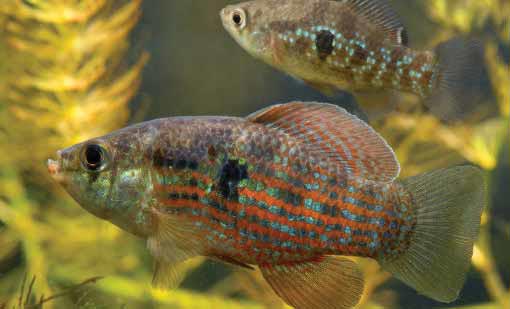
Jordanella floridae, the American Flagfish, can show magnificent coloration and is an ideal candidate for small outdoor pools. Image by Matthew Wittenrich/Aquatic Pixels.
Koi are out, unless the pond has a minimum capacity of 300 gallons and a good water filtration system. And what about goldfish, those quintessential pond fish? If overstocked, they will quickly exhaust the oxygen and pollute a small pond. Plan on at least 50 gallons for one small pair of goldfish. And while they may seem perfect for summer, what happens in the fall, when the party moves back indoors? Few aquarium hobbyists have ever seen an adult goldfish, which are sometimes measured in pounds rather than length, as with most aquarium fishes. One of the most beautiful aquariums I’ve ever seen was about 70 gallons and home to three adult red and white Fantail Goldfish. Any more fish, and the tank would have been overcrowded. So this is what happens when goldfish grow up, which is what they do when we take good care of them. The adult size of goldfish isn’t a problem in the traditional dug pond, where the fish remain year ’round, but if you plan to move the fish inside, be prepared to dedicate a substantial aquarium to their keeping.
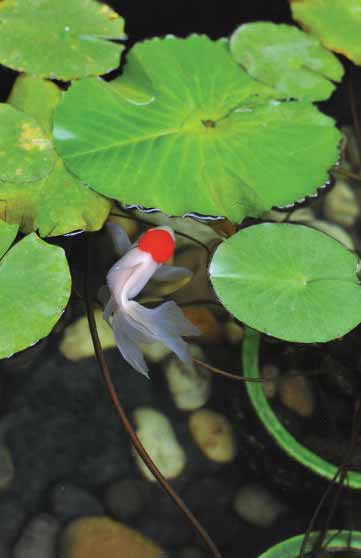
A classic pond species, the Goldfish, Carassius auratus auratus, demands a pond of 50 gallons or more and a place to spend the winter indoors. Neither goldfish nor koi are recommended for small water features. Image by Bluefand/Shutterstock
Some aquarists like to use emersed growth plants to add height and interest and shade for the fishes. The rules sometimes get broken, but some of the plants we see as marginals, like Peace Lilies, Spathiphyllum spp., are quite willing to grow in a small container with inert media in the patio pond, raising their white flowers like flags of peace above the water. Irises, too, planted just before bloom, will surpass all expectations. Most serious garden centers now have a selection of aquatic plants that will grow emersed, while your local aquarium will have a mixture of those that stay submerged and those that reach toward the sun.
In the summertime, when the weather’s fine and the days grow longer, the evening ritual moves to the outdoors. Regardless of accommodations—whether a cozy patio of stone or brick, a wooden deck, a high-rise urban balcony, or even the ubiquitous city fire escape—the lure of a long, relaxing evening ahead, in one’s favorite company and among the fishes, is a suitable reward for a hard day’s work.
CONTAINER POND BASICS
- Choose the location carefully. Most aquatic plants will do best with at least several hours of full or filtered sunlight per day.
- Lightly stocked ponds can operate without filtration or heaters, but having access to electricity allows better water quality control and extended seasons in temperate climates.
- Add water to a new pond first, letting it age for several days or adding dechlorinator.
- Next add plants and substrate. Bioseeding with water or filter squeezings from an established aquarium will speed the development of populations of beneficial bacteria. After several days or longer, introduce fishes gradually.
- Smaller species do best in smaller water gardens. Goldfish and koi will die of oxygen starvation or fail to thrive in small ponds. Snails, bottom feeders such as Corydoras catfishes, and small shrimps will assist in natural maintenance.
- Feed lightly at least twice a day. Add and/or change water as needed. Be sure that lawn and garden chemicals are never allowed to contaminate the pond.
- Fishes should be able to keep a small pond from becoming a breeding ground for mosquitoes.
- Be prepared to take livestock and plants indoors for overwintering when temperatures drop in the fall.
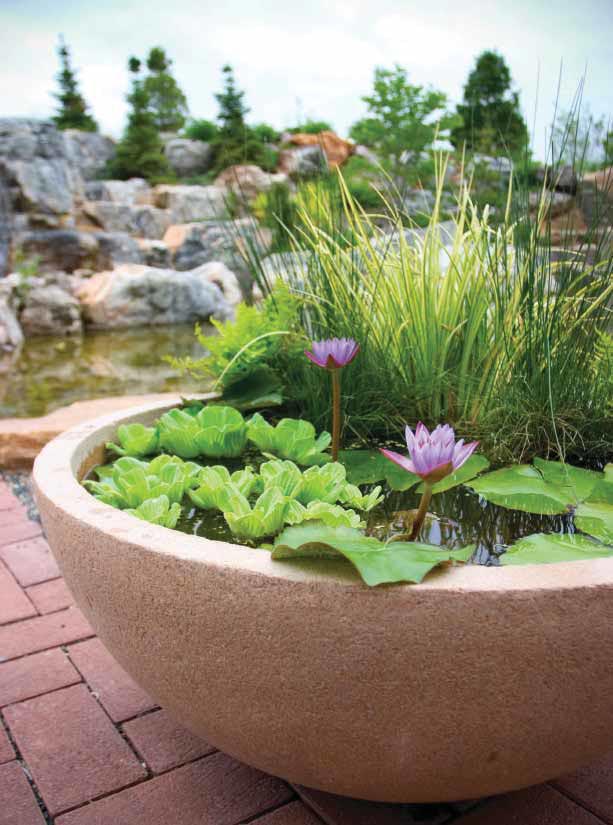
Floating plants and water lily pads provide shade during the heat of the day and also discourage fishes from jumping during spawning frenzies. Image by Aquascape Inc., www.aquascapeinc.com
Mary Sweeney is the co-author of A PocketExpert Guide: Tropical Fishes (2009, Microcosm/TFH Professional Series).
Want More? Expand your personal library today!
Before you dive into keeping tropical and temperate fishes in patio ponds this summer season, make sure your library is complete.
- Forever preserve Mary Sweeney’s Fair-weather Ponding in your reference library when you order the May/June 2012 issue of AMAZONAS Magazine, WILD & DOMESTICATED AQUATIC PLANTS. Click the cover below to order this issue.
- Rachel O’Leary’s look at large scale outdoor aquatics is a must read. Check out The Outdoor Aquarist in the July/August 2014 issue of AMAZONAS Magazine, GIANT FISHES. Click the cover below to order this issue.
Learn more about a convenient and personal subscription to AMAZONAS, the world’s premier freshwater aquarium magazine.
Still Want More?
Explore Matt Pedersen’s successes and failures with container ponding in his online series Tropical Outdoor Whiskey Barrel Ponds, Part I, Part II, and Part III.

